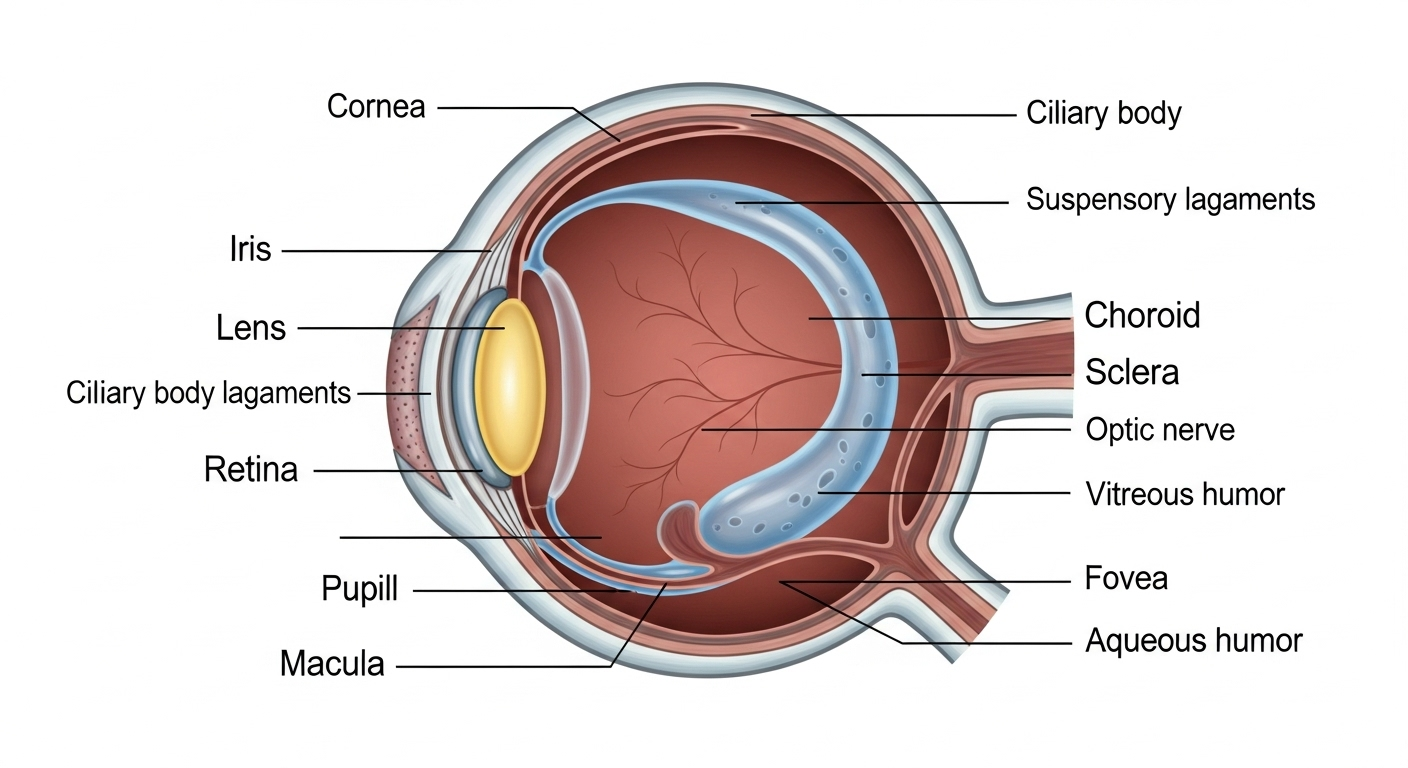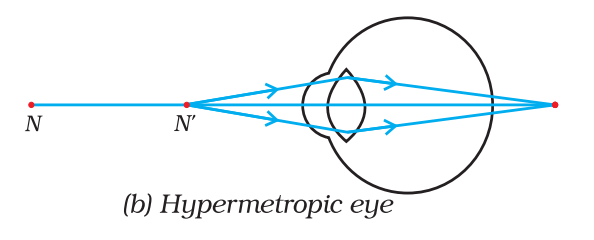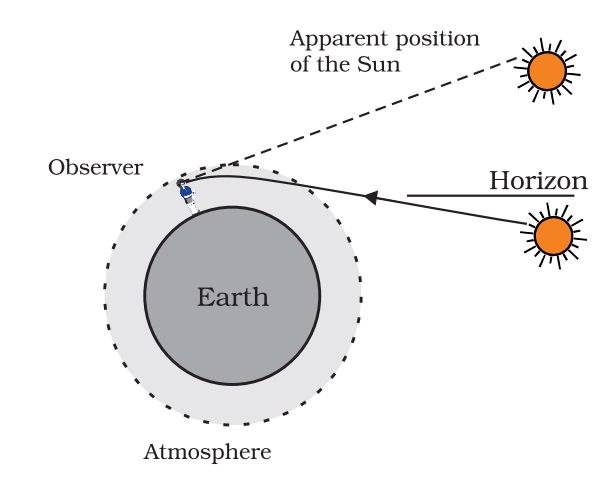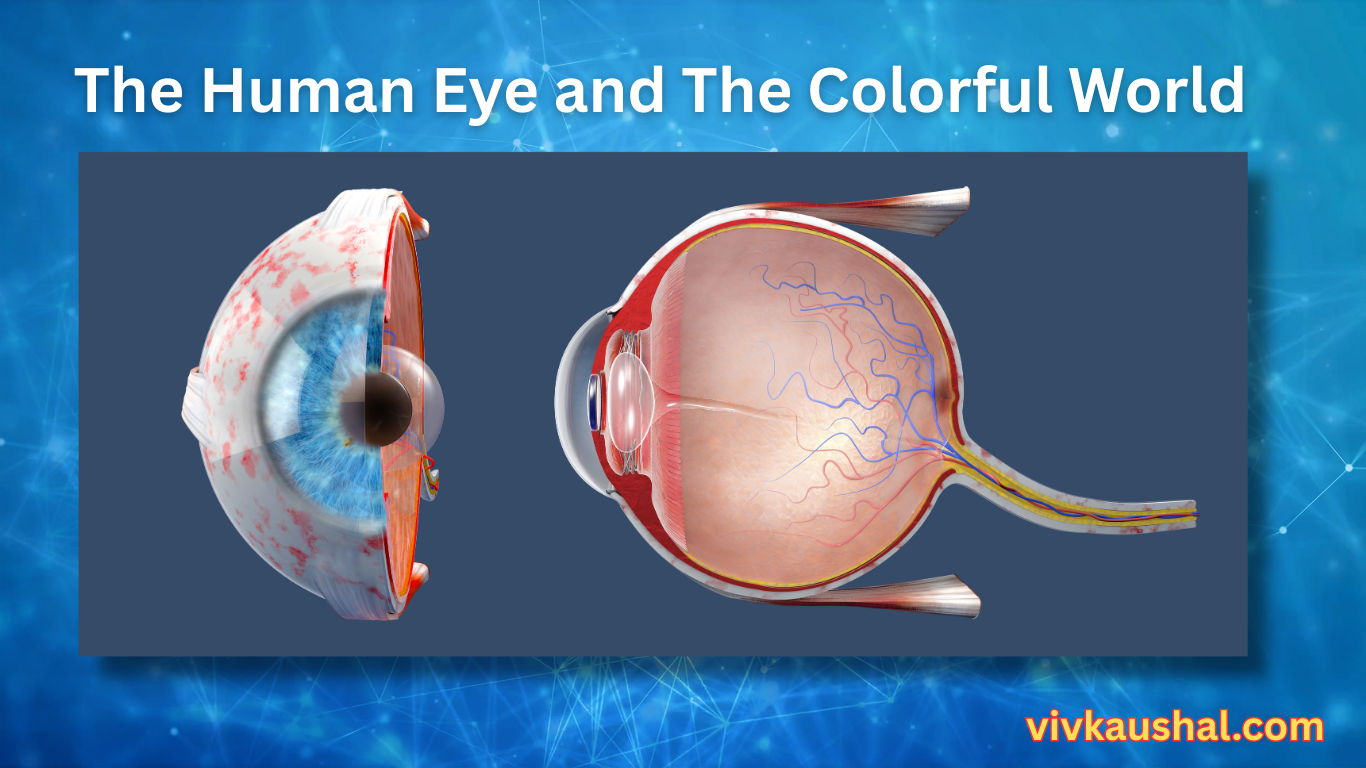The Human Eye – Textbook Exercise Questions

1. The human eye can focus objects at different distances by adjusting the focal length of the eye lens. This is due to:
(b) accommodation
Accommodation is the special ability of the eye lens to change its shape and therefore its focal length, allowing us to see both distant and nearby objects clearly.
2. The human eye forms the image of an object at its:
(d) retina.
The retina is the light-sensitive screen at the back of the eye, similar to the film in a camera. The eye lens focuses the light to form an image on the retina.
3. The least distance of distinct vision for a young adult with normal vision is about:
(c) 25 cm
This is the closest distance at which a person can see an object clearly without putting any strain on their eyes.
4. The change in focal length of an eye lens is caused by the action of the:
(c) ciliary muscles
The ciliary muscles contract and relax to change the shape and curvature of the eye lens, which in turn changes its focal length.
5. A person needs a lens of power –5.5 D for correcting his distant vision. For correcting his near vision, he needs a lens of power +1.5 D. What is the focal length of the lens required for correcting distant vision and near vision?
For Distant Vision:
-
Given: Power (P₁) = -5.5 D
-
Formula: Focal length (f) = 1 / Power (P)
-
Solution:
f₁ = 1 / (-5.5)
f₁ = -0.1818 m
To convert to cm, multiply by 100: f₁ = -18.18 cm.
The focal length for correcting distant vision is -18.18 cm.
For Near Vision:
-
Given: Power (P₂) = +1.5 D
-
Formula: Focal length (f) = 1 / Power (P)
-
Solution:
f₂ = 1 / (+1.5)
f₂ = +0.667 m
To convert to cm, multiply by 100: f₂ = +66.7 cm.
The focal length for correcting near vision is +66.7 cm.
6. The far point of a myopic person is 80 cm in front of the eye. What is the nature and power of the lens required to correct the problem?
-
Analysis: The person has myopia (near-sightedness). To correct this, the lens must take an object at infinity (a distant object) and form its image at the person’s far point (80 cm).
-
Nature of lens: Myopia is corrected using a concave lens.
-
Calculation:
-
Object distance (u) = ∞ (infinity)
-
Image distance (v) = -80 cm (the far point of the eye) = -0.8 m
-
Using the lens formula, 1/f = 1/v – 1/u:
1/f = 1/(-0.8) – 1/∞
Since 1/∞ is 0,
1/f = -1/0.8
f = -0.8 m -
Now, calculate the power (P = 1/f):
P = 1 / (-0.8)
P = -1.25 D
The person needs a concave lens with a power of -1.25 D.
-
7. Make a diagram to show how hypermetropia is corrected. The near point of a hypermetropic eye is 1 m. What is the power of the lens required to correct this defect? Assume that the near point of the normal eye is 25 cm.
-
The first diagram should show a hypermetropic eye with light rays from a nearby object (at 25 cm) converging at a point behind the retina.

-
The second diagram should show the same eye, but with a convex lens placed in front of it. The convex lens helps converge the light rays so they now focus correctly on the retina.

-
Analysis: The person has hypermetropia (far-sightedness). They want to read an object held at the normal near point (25 cm), but can only see clearly starting from 1 m. The corrective lens must take an object at 25 cm and form a virtual image at 1 m (100 cm) so the person can see it.
-
Calculation:
-
Object distance (u) = -25 cm (where the object is actually placed)
-
Image distance (v) = -100 cm (where the image needs to be formed for the eye to see it)
-
Using the lens formula, 1/f = 1/v – 1/u:
1/f = 1/(-100) – 1/(-25)
1/f = -1/100 + 1/25
1/f = (-1 + 4) / 100 = 3/100
f = +100/3 cm = +33.3 cm = +0.333 m -
Now, calculate the power (P = 1/f):
P = 1 / (1/3) (using the fraction 100/3 cm = 1/3 m is more accurate)
P = +3 D
The person needs a convex lens with a power of +3 D.
-
8. Why is a normal eye not able to see clearly the objects placed closer than 25 cm?
The eye focuses on objects by making the eye lens thicker or thinner, which is done by the ciliary muscles. For very close objects, the ciliary muscles must contract as much as possible to make the lens very thick (highly convex). There is a limit to how much these muscles can contract. If an object is brought closer than 25 cm, the lens cannot become thick enough to focus the light onto the retina, and the image appears blurry.
9. What happens to the image distance in the eye when we increase the distance of an object from the eye?
The image distance in the eye remains the same. The distance between the eye lens and the retina is fixed. To keep the image focused on the retina, the eye adjusts the focal length of its lens through accommodation. It does not change the image distance.
10. Why do stars twinkle?
Stars twinkle because of atmospheric refraction. Stars are very far away, so they act as point sources of light. As the light from a star enters the Earth’s atmosphere, it passes through different layers of air that have varying temperatures and densities. This causes the starlight to bend continuously and randomly. As the path of the light slightly changes, the apparent position of the star shifts, and the amount of light entering our eye flickers. This flickering effect is what we perceive as twinkling.

11. Why do planets not appear to twinkle?
Planets are much closer to Earth than stars, so they do not appear as point sources. Instead, they can be considered a collection of a very large number of point sources. While the light from each individual point flickers due to atmospheric refraction, the effects average out. The dimming effect from one point is cancelled by the brightening effect from another, so the overall brightness remains constant, and planets do not twinkle.
12. Why does the sun appear reddish in the morning (as well as in the evening)?
This happens due to the scattering of light by the Earth’s atmosphere. At sunrise and sunset, the sun is near the horizon, and its light has to travel through a much thicker layer of the atmosphere to reach our eyes. As the light travels, most of the shorter-wavelength light (like blue and violet) is scattered away by the air particles. Only the longer-wavelength light (like red, orange, and yellow) is able to pass through and reach us. This is why the sun and the sky around it look reddish.

13. Why does the sky appear dark instead of blue to an astronaut?
The blue color of the sky is caused by the scattering of sunlight by particles in the Earth’s atmosphere. In space, there is no atmosphere, which means there are no particles to scatter the sunlight. Without this scattering, the light from the sun travels in a straight line, and the sky appears dark or black.
InText Questions
1. What is meant by the power of accommodation of the eye?
The power of accommodation is the ability of the eye lens to adjust its focal length, with the help of ciliary muscles, so that it can form a clear image on the retina for objects at different distances, from infinity to as close as 25 cm.
2. A person with a myopic eye cannot see objects beyond 1.2 m distinctly. What should be the type of the corrective lens used to restore proper vision?
The person is suffering from myopia (near-sightedness). To correct this defect, a concave lens is used. This lens will diverge the light from distant objects so that they appear to be coming from the person’s far point (1.2 m), allowing the eye to focus on them clearly.
3. What is the far point and near point of the human eye with normal vision?
For a human eye with normal vision:
-
The near point is 25 cm. This is the closest an object can be and still be seen clearly.
-
The far point is at infinity. This means a person with normal vision can see distant objects clearly.
4. A student has difficulty in reading the blackboard while sitting in the last row. What could be the defect the child is suffering from? How can it be corrected?
-
Defect: The child is unable to see distant objects clearly, which means they are suffering from myopia (near-sightedness).
-
Correction: This defect can be corrected by using spectacles with a concave lens of the appropriate power. The lens will help to focus the light from the distant blackboard correctly onto the retina.



